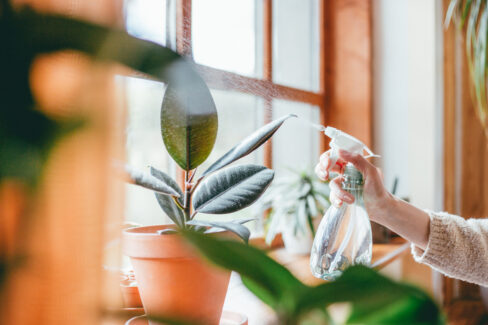Last updated on October 23rd, 2023 at 08:53 pm
Since the rubber tree is not hardy, it should not be outdoors all year round. As a rule, it is also kept more as a houseplant. The question is how it will survive the winter.
Even temperatures below 10 °C can cause significant damage to the plant. The rubber tree can stand in the living room all year round, but is also happy to spend the winter a little cooler.

Contents
Does my rubber tree need a winter rest?
Although winter rest is not absolutely necessary for the rubber tree, it can be very beneficial to it. During this time, the rubber tree is allowed to recover. It needs less water than in summer and should not be fertilized at all until spring.
Ideally, the temperature in the winter quarters are between 12 ° C and 16 ° C. In addition, it should be bright, because a rubber tree always needs a lot of light. It does not tolerate drafts at all. In spring, let the rubber tree move again in time to a warmer room.
Although your rubber tree does not necessarily need to be in winter quarters, a winter rest would do it good under certain circumstances. The temperature may be cooler in the winter quarters, but should not drop below 12 °C. Water your rubber tree less than in summer and do not fertilize it at all until spring.
The most important winter tips in brief:
- not hardy
- winter dormancy possible, not inevitable
- ideal temperature during hibernation: about 12 °C
- water less than in summer
- do not fertilize
Tips
During the winter, the rubber tree is welcome to stand a little cooler than in the summer months.
Since the rubber tree, bot. Ficus elastica, does not survive the winter outdoors, it must spend the cold season indoors. However, there are several concepts of how to get the houseplant through the winter well.
Light
Regardless of which of the following concepts you choose, the rubber tree needs plenty of light even in winter, but it should be protected from blazing midday sun. In an average room, light conditions should be sufficient if Ficus elastica is placed close to a window and you do not darken it throughout the day.
If the houseplant has been given a location further away from a window, the rubber tree may find it too dark during the winter months. You can see signs of this in its leaves.
Concept 1: Rubber tree keeps its location
Moving to winter quarters is not necessarily necessary for Ficus elastica if the location is warm enough during the cold season. Since the rubber tree feels really comfortable at a temperature of 16 to 20 degrees Celsius, it can spend the winter in its usual location, if the room is heated. In this case, you do not need to change anything in terms of care.
Concept 2: Change of location
The concept “change of location” pursues the idea of sending the rubber tree into a winter dormancy. During this, Ficus elastica should gather strength for the next growing season. In order for the plant to adhere to the prescribed rest, you should move the indoor plant
- between October and February
- place it in a cooler place and
- reduce the care.
- Cooler place and winter care
How cool you can put the rubber tree in the winter quarters depends on its original location, because you should not expose Ficus elsatica to “cold shock”. Therefore, in very warm locations, the temperature should be at the lower limit of the comfortable temperature (16 degrees Celsius). If his place was a little cooler even in the summer, you can dare to try to send him into hibernation at twelve degrees Celsius.
In any case, it should not be under cold drafts, because these temperatures the rubber tree can not tolerate, even if you only briefly ventilate the room.
Winter dormancy is also accompanied by reduced care:
- Gradually reduce watering, but never let it dry out completely.
- Stop giving fertilizer or fertilize no more than once or twice during winter dormancy
Does my rubber tree need special care in the spring?
If your rubber tree has overwintered in another room, then it may move back to its usual location in the spring. This time is also ideal for repotting. If you would like to set, then you should cut them in the spring.
At the beginning of the growing season, it is also time to water your rubber tree more again and the first fertilizer application of the year is now due. If the Ice Saints are over, then you can also think about giving the tree a summer break in the garden. This will keep it healthy and vital.
Be sure to acclimate your rubber tree slowly to fresh air. Put it in the light shade at the beginning, later it may also stand in the sun for a few hours, but not during midday. Brown spots or sunburn could be the result.
The most important things in a nutshell:
- not winterproof
- winter rest is not necessary but useful
- ideal temperature in winter: approx. 12 °C to 16 °C
- bright place
- free from drafts
Tips
The rubber tree is by no means hardy, even temperatures just above freezing can cause it serious damage.


